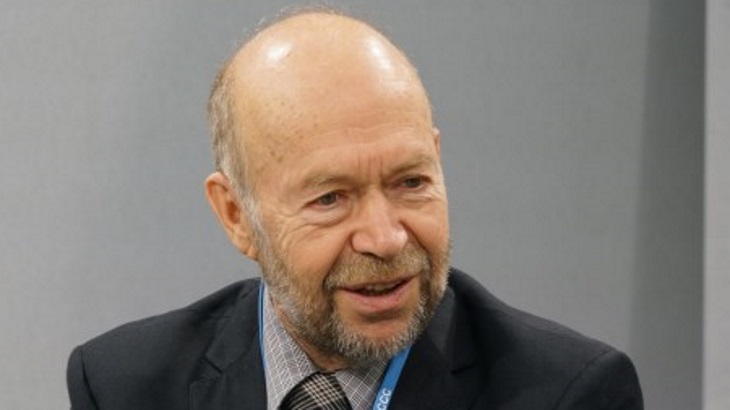Formerly a research at Nasa, Hansen's testimony before the US Senate helped raise wider awareness of global warming back in 1988. To his 3 February letter to Johnson, Hansen copied in the newly appointed US climate envoy, John Kerry, who told the BBC last week that the UN climate talks in Glasgow, in November, will be the "last best chance" the world has for tackling the climate crisis.
Hansen's five-page letter was published in full by The Guardian newspaper.
"In leading the UK, as host to the COP, you have a chance to change the course of our climate trajectory, earning the UK and yourself historic accolades or you can stick with business-almost-as-usual and be vilified in the streets of Glasgow, London, and around the world," Hansen wrote to Johnson.
"It would be easy to achieve this latter ignominy and humiliation. Just continue with the plan to open a new coal mine in Cumbria and continue to invest funds of the British public in fossil fuel projects overseas, in contemptuous disregard of the future of young people and nature. The contrary path is not so easy, but, with your leadership, it is realistic."
The UK accounts for about 1% of global emissions today but global warming is proportional to cumulative emissions, Hansen noted.
"The UK is responsible for about 5% of total emissions. UK and US cumulative emissions are each a factor of five larger than our respective portions of global population. Our large energy use served a good purpose: it raised our standards of living. But in recent decades the climate situation has emerged with clarity. We must find a new energy path in the mature economies and cooperate with emerging economies, so they can raise living standards with clean carbon-free energies.
"Despite subsidies of renewable energy, global emissions increased. Despite the current health pandemic, high energy demand continues and energy growth will re-emerge. However, an effective response to climate change requires that global emissions decline rapidly in the next few decades."
The future will be determined by the changes to the global atmosphere, the most relevant of which is the increasing amount of atmospheric CO2, Hansen said.
"Global energy use and emissions still being tabulated declined in the past year, but high emissions will continue unless decisive action informed by science is undertaken. Specifically, the science reveals that to stem the climate tide we need to phase out fossil fuel emissions by mid-century at the latest and obtain our energy from carbon-free sources such as renewable energy and nuclear power. This may seem to be a tall order, but in fact it is doable."
Nuclear regions achieve 2030 targets
The NIA yesterday published its analysis of recent data from the National Grid Electricity System Operator. It found that Southern Scotland, North East England and North West England had the cleanest power, hitting the UK’s 2030 electricity decarbonisation target of 50-100 g CO2 per kWh of electricity on more than 85% of days in 2020. Southern Scotland had a mean daily carbon intensity of 43 g, North East England 47 g, and North West England 53 g.
Southern Scotland and North West England both have two operational nuclear power plants alongside substantial renewable capacity, while North East England is home to Hartlepool nuclear power plant and a number of wind farms.
The UK as a whole averaged just over 180 g and only hit the 2030 target on 13 days. Gas remains the leading source of both power and carbon emissions, passing 60% of daily generation at times in June, August and September. Coal was burned in both summer and winter months to top up supplies, as fossil fuel use soared during times of high demand. Carbon intensity peaked over 300 g on 21-24 January and 4-6 March, but also approached 300 g in late August and mid-September when weather conditions squeezed supply and drove demand.
Nationally, nuclear power was the leading zero-carbon generator on 158 days out of 358 days (44%) for which data is published, with wind power leading on the other 200 days. The nuclear fleet produced the most clean power in April, May, June and July, with wind leading in the other eight months. Seven of the UK's eight nuclear power stations, however, are due to retire by 2030, with the first four to be in defuelling by the end of March 2024.
"Nuclear power, in partnership with renewables, is essential to reaching net zero. We should re-create what we have achieved in Northern England and Southern Scotland across the country: getting nuclear and renewables working together to cut emissions. To do that, we need to build new nuclear power stations alongside renewable capacity," NIA Chief Executive Tom Greatrex said.
"These figures show the great service our existing fleet has rendered to the nation, but the time has come to build a new fleet. That investment, as part of a robust zero-carbon mix, will kickstart a green recovery and our transition to a green economy," he added.
The UK's Climate Change Committee estimated in its Sixth Carbon Budget, published last December, that without new projects, zero-carbon generation will fall from 130 TWh in 2020 to just 90 TWh in 2030 because of nuclear fleet retirements. It puts the share of nuclear in the country's electricity mix at between 5 GW and 10 GW by 2050.
The UK currently generates about 20% of its power from nuclear, but nearly half of its current capacity is to be retired by 2025. One new plant is under construction, Hinkley Point C, while the government has yet to confirm its support for a second, Sizewell C.





_18570.jpg)
_16159.jpg)
_49205.jpg)
_18938.jpg)





